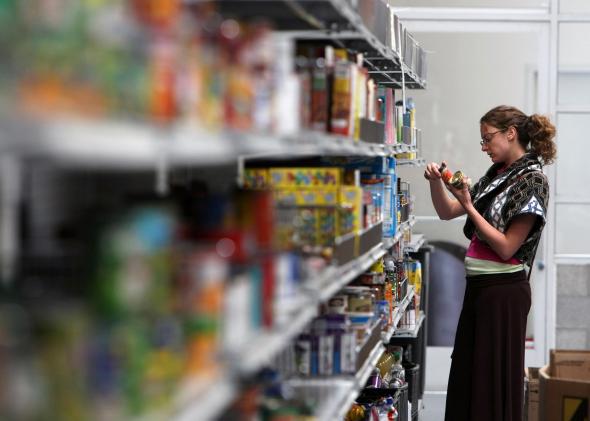In 2006, the U.S. Department of Agriculture adopted the term food insecurity to describe the “economic and social condition of limited or uncertain access to adequate food.” Like so much bureaucratic jargon, the phrase is clinical and opaque. Food insecurity may be more exact than the old term, hunger, but it doesn’t convey much about what it’s like not to have enough to eat on a regular basis.
This week, journalist Tracie McMillan has a multimedia piece in National Geographic that sheds light on the lived experiences behind the jargon. Forty-eight million Americans faced empty cupboards at some point in 2012, and three-quarters of them live in working households. The problem is not that food prices have gone up—thanks to federal subsidies, junk food is cheaper than ever. The problem is that real wages have gone down, which forces poor people to choose between paying their bills and buying food. This is true even for families that receive food stamps, and Congress’s decision to cut the Supplemental Nutrition Assistance Program last year certainly didn’t help matters. (I should disclose that I’m friendly with McMillan and have edited some of her work for Slate.)
McMillan takes aim at various misconceptions about poverty and hunger by profiling four families across the country. Think all you need to eat healthy on a budget is cooking skill? Talk to Jacqueline Christian, a mother of two who works full-time as a health aide and wouldn’t have the time or energy to cook even if she weren’t living in a homeless shelter. Think it’s impossible to struggle with hunger if you’re overweight? Spend some time with Christina Dreier, an obese stay-at-home mom in Iowa who skips meals in order to feed her kids tater tots and hot dogs from a local food bank. Think food banks are an adequate safety net for the food insecure? Go shop at one with Kyera Reams, another Iowa mom who tells McMillan, “We wouldn’t eat healthy at all if we lived off the food-bank food,” and who literally devotes most of her waking hours to cooking, canning, foraging, and gardening so that her kids can have fruits and vegetables.
What goes unsaid in McMillan’s article is that the task of feeding children on an inadequate budget falls primarily to women. That women still do the majority of household labor is well known, but usually it’s discussed in the context of middle-class obsessions like leaning in and the mommy wars, not in the context of growing poverty.
McMillan shows just how heavily domestic duties weigh on food-insecure women—both the practical and menial labor of getting dinner on the table, and also the emotional labor required to negotiate with hungry kids. Dreier tries to cajole her three-year-old son into eating the free breakfast at his preschool, but he refuses, so she heats up the last of the food in her freezer for him, even though she and her husband don’t have the money to replace it. Christian gives into her kids’ plea for drive-through fried chicken, even though it requires borrowing money from her mom, because she doesn’t want to “let them down.” Another mother living in a multigenerational household tells her kids “if they keep wasting [food], we have to go live on the corner, beg for money, or something.”
These exchanges are exhausting and heartbreaking to read about—but it’s worth your time to do so. It’s common to see headlines about how poverty disproportionally affects women, but it’s rare to get such a clear glimpse of what that really means.
